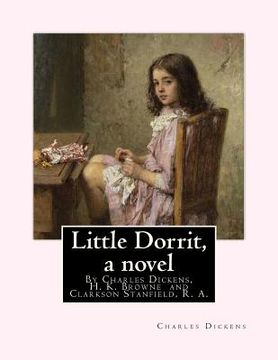Little Dorrit, By Charles Dickens, H. K. Browne illustrator, and dedicted by Clarkson Stanfield, R. A.: Hablot Knight Browne (10 July 1815 - 8 July 18 (en Inglés)
Reseña del libro "Little Dorrit, By Charles Dickens, H. K. Browne illustrator, and dedicted by Clarkson Stanfield, R. A.: Hablot Knight Browne (10 July 1815 - 8 July 18 (en Inglés)"
Little Dorrit is a novel by Charles Dickens, originally published in serial form between 1855 and 1857. It satirizes the shortcomings of both government and society, including the institution of debtors' prisons, where debtors were imprisoned, unable to work, until they repaid their debts. The prison in this case is the Marshalsea, where Dickens's own father had been imprisoned. Dickens is also critical of the lack of a social safety net, the treatment and safety of industrial workers, as well the bureaucracy of the British Treasury, in the form of his fictional "Circumlocution Office". In addition he satirizes the stratification of society that results from the British class system.Little Dorrit is a novel by Charles Dickens, originally published in serial form between 1855 and 1857. It satirizes the shortcomings of both government and society, including the institution of debtors' prisons, where debtors were imprisoned, unable to work, until they repaid their debts. The prison in this case is the Marshalsea, where Dickens's own father had been imprisoned. Dickens is also critical of the lack of a social safety net, the treatment and safety of industrial workers, as well the bureaucracy of the British Treasury, in the form of his fictional "Circumlocution Office". In addition he satirizes the stratification of society that results from the British class system.The novel begins in Marseilles "thirty years ago" (i.e., c. 1826), with the notorious murderer Rigaud telling his cell mate how he killed his wife. Arthur Clennam is returning to London to see his mother after the death of his father, with whom he had lived for twenty years in China. On his deathbed, his father had given him a mysterious watch murmuring "Your mother," which Arthur naturally assumed was intended for Mrs. Clennam, whom he and everyone else believed to be his mother.Inside the watch casing was an old silk paper with the initials DNF (Do Not Forget) worked into it in beads. It was a message, but when Arthur showed it to the harsh and implacable Mrs Clennam, a religious fanatic, she refused to tell him what it meant and the two become estranged. In London, William Dorrit, imprisoned as a debtor, has been a resident of Marshalsea debtors' prison for so long that his three children - snobbish Fanny, idle Edward (known as Tip) and Amy (known as Little Dorrit) - have all grown up there, although they are free to pass in and out of the prison as they please. Little Dorrit, devoted to her father, has been supporting them both through her sewing. Once in London, Arthur is reacquainted with his former fiancée Flora Finching, who is now overweight and simpering. His supposed mother, Mrs Clennam, though arthritic and wheelchair-bound, still runs the family business with the help of her servant Jeremiah Flintwinch and his downtrodden wife Affery. When Arthur learns that Mrs Clennam has employed Little Dorrit as a seamstress, showing her unusual kindness, he wonders whether the young girl might be connected with the mystery of the watch. Suspecting his mother was partially responsible for the misfortunes of the Dorrits, Arthur follows the girl to the Marshalsea. He vainly tries to inquire about William Dorrit's debt in the poorly run Circumlocution Office, assuming the role of benefactor towards Little Dorrit, her father, and her brother. While at the Circumlocution Office he meets the struggling inventor Daniel Doyce, whom he decides to help by going into business with him. The grateful Little Dorrit falls in love with Arthur, but Arthur fails to recognise Little Dorrit's interest. At last, aided by the indefatigable rent-collector Pancks, Arthur discovers that William Dorrit is the lost heir to a large fortune, finally enabling him to pay his way out of prison.....
Charles Dickens (1812-1870) nació en Portsmouth y era el primogénito varón de un funcionario de la Armada Real. A los doce años, el encarcelamiento de su padre por deudas lo obligó a ponerse a trabajar en una fábrica de betún. Su educación fue irregular: aprendió por su cuenta taquigrafía, trabajó como ayudante en el bufete de un abogado y finalmente fue corresponsal parlamentario del Morning Chronicle. Sus artículos, luego recogidos en Escenas de la vida de Londres por «Boz» (1836-1837), tuvieron gran éxito y, con la aparición en 1837 de Los papeles póstumos del Club Pickwick, Dickens se convirtió en un auténtico fenómeno editorial. Novelas como Oliver Twist (1837-1839), Nicholas Nickleby (1838-1839) o Barnaby Rudge (1841) alcanzaron enorme popularidad, así como algunas crónicas de viajes, como Estampas de Italia (1846). Con Dombey e hijo (1846-1848) inició su época de madurez, de la que son buenos ejemplos David Copperfield (1849-1850), su primera novela en primera persona y su favorita, en la que desarrolló algunos episodios autobiográficos; La Casa lúgubre (1852-1853); La pequeña Dorrit (1855-1857), Historia de dos ciudades (1859), Grandes esperanzas (1860-1861) y Nuestro amigo común (1864-1865). Murió en Gad's Hill, su casa de campo en Higham, en el condado de Kent.
Ver más
Ver menos

